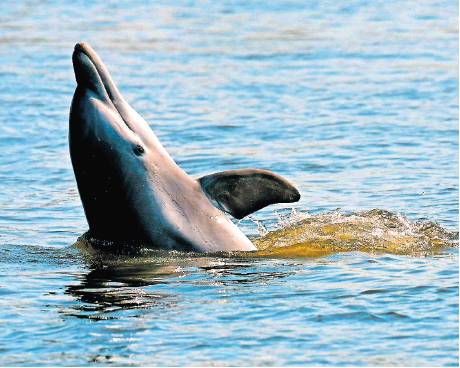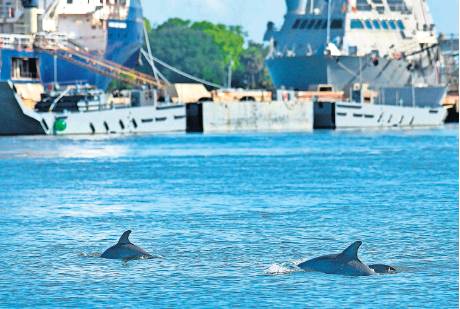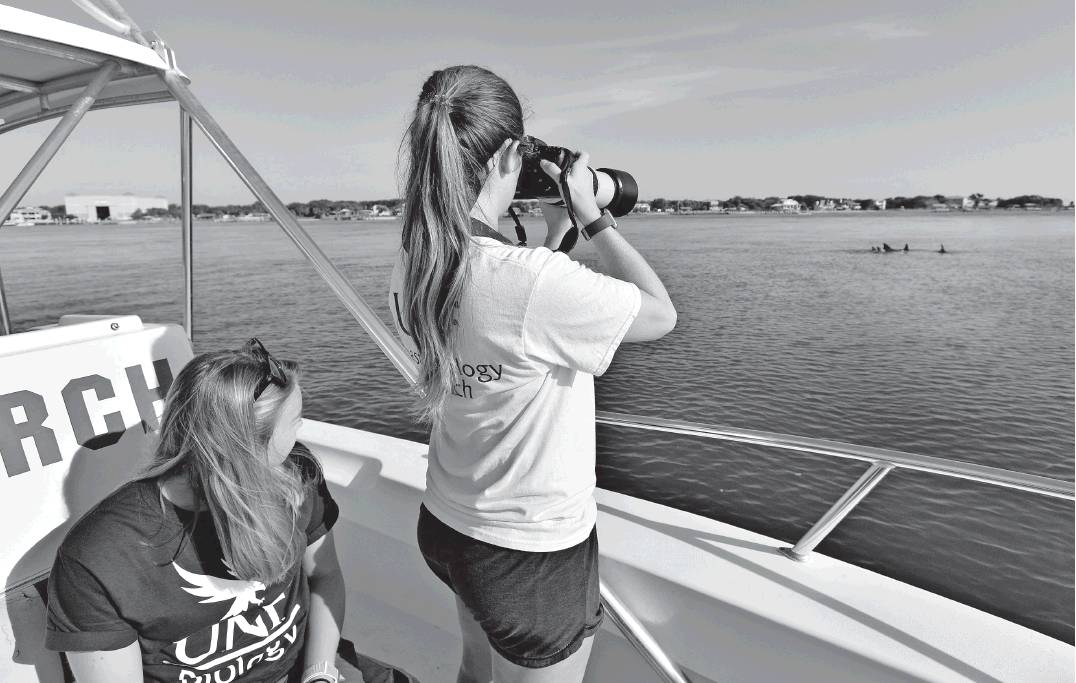ANOTHER VIEW
Tracking our urban dolphins
By Carole Hawkins
In the middle of the St. Johns River if the water is calm, you might hear a sound like waves crashing on a shore. Look up and you’ll see a group of bottlenose dolphins rhythmically rising and diving, in pace with your boat.
When synchronized movement happens between humans, it creates a soothing bond. Link up with a group of dolphins, and you’re in a dance with the wilderness.
Downtown Jacksonville has earned an international reputation for its dolphins.
Our river has lots of them. What’s more, Jacksonville’s male dolphins work together in a mating strategy that’s so complex and rare, only one other group of dolphins in the world is known to behave like it.
The male dolphins team up to wrangle a female, tussle with other teams, and join forces with allies when they are outgunned.
“It’s definitely drawing the attention of researchers within the marine mammal community,” said Quincy Gibson, head of UNF’s Dolphin Research Program. “When people talk about male alliances, they talk about Jacksonville’s dolphins.”
For those who support Downtown redevelopment, having a rare dolphin population in the St. Johns River cuts both ways.
It complicates industrial progress, in the case of something like dredging a shipping channel.
But it bolsters a green city agenda. Step aboard Downtown’s River Taxi, and you instantly cross a threshold from sun-baked high rises and buzzing streets to lapping waves and spray-filled breezes. See a dolphin breach the water’s surface amid a Downtown skyline, and you’re connected to a unique ecosystem.
What are they doing here?
If you’re a dolphin, Jacksonville might seem like the worst place to be. The St. Johns River is muddy and the currents are strong. Dolphins face pollution, noise, boat strikes and algal blooms.
When Gibson began her research at UNF nine years ago, she thought she’d find the most dolphins in the quiet, more pristine Intracoastal Waterway. Today she knows better.
Along the Florida east coast, the two big dolphin hot spots are Central Florida’s Indian River Lagoon and Jacksonville’s St. Johns River. Five times more bottlenose dolphins live near Jacksonville than anyplace in between. We don’t really know why.
“Given all of the negatives, there has to be something really critical and positive for them about this habitat,” Gibson said.
It could be there’s a lot of prey. The intersection of the St. Johns and the Intracoastal funnels dinners of fish — like mullet, sheep’s head, flounder and red drum — into one large foraging area.
It could be that the St. Johns River’s shallow tributaries are a great spot to calve baby dolphins.
We do know about half of Jacksonville’s roughly 300 dolphins live here year-round. The other half appear to be “snowbirds,” traveling up and down the Intracoastal to Jacksonville in the summer and the Indian River Lagoon in the winter.
During Jacksonville’s lean winter months, the dolphins range from the mouth of the river to the Dames Point bridge. During the summer months when their numbers swell, dolphins stretch all the way to the Main Street Bridge. Some venture as far inland as Green Cove Springs.
Dolphin chasers
UNF researchers have taken to the St. Johns River almost every week since 2011 to study the dolphins. They pilot a route that begins at Mayport and ends at the Hart Bridge. The trip usually takes all day.
When they see a dolphin, they stop and move closer, slowly. The lead researcher snaps photos and barks observations, while a second writes everything on data sheets. Others record the GPS position, the water temperature, the salinity and sea state.
It can be tedious doing the same thing over and over again, said grad student researcher Britney DiVittore. But also, rewarding.
“No matter how many times I’ve seen dolphins in the wild, I’m still excited when we spot one,” she said. “It’s an opportunity to understand what’s going on with them a little better.”
Researchers identify individual dolphins by their dorsal fins — the shape, notches, nicks, scratches and rakes. Once you can recognize a dolphin, you begin to see patterns in its behavior. Personalities emerge. The dolphins get names.
It started with Kermit, Grover and Gonzo. After Muppet names ran out, the researchers moved on to Disney princesses, Hawaiian names and Greek gods. The naming ritual takes a page from famous primate researcher Jane Goodall, who named the chimpanzees she studied. There’s a practical reason for it.
“If I tried to remember a four-digit number for each animal, there’s absolutely no way I could do it,” said Gibson. “But when I see Pocahontas, I know Pocahontas and I remember everything about her. My brain just works better that way.”
Knowing the dolphins personally also helps researchers unravel the mysteries of their behavior. Soon, the UNF team made a startling discovery — Jacksonville’s male dolphins were using complex alliances to guard their mates. The only other place where that’s been seen is Shark Bay Australia.
Enemies and allies
It’s common for males to guard their mates. Primates, turkeys and lots of other animals do it to protect their bloodline. In a more complex society, the males team up to guard the females. One of them gets to mate. The other is more like a buddy who has his back.
This team approach is common among all dolphins. They work in pairs and trios to corral a female into their pod. But with Jacksonville’s dolphins, the mating politics get even more complex.
Dolphin teams form alliances with other dolphin teams. Like middle school cliques, there are cool kids and the kids who get pushed out. When it comes to women, there are rumbles. It looks a bit like “West Side Story,” but on the river.
Kristy Brightwell, former lab manager for the Dolphin Research Program, remembers the first day she saw it. Two male teams converged and swam off as a unit. The water churned, then there was a ferocious splashing. When the researchers caught up, they saw the four dolphins had captured a female.
Dolphins don’t have twins, so only one dolphin is able to successfully mate with a particular female per year. The others are just there to help score the touchdown. Once a female is stolen, the second team swims off.
“It was an amazing experience,” Brightwell said “It was like, yes! That’s why we’re studying this!”
Must love dolphins
Jacksonville’s dolphins may be a rare sort. So is the woman in charge of studying them.
Gibson is a marine mammal biologist who’s known since she was 5 years old she wanted to work with dolphins. Her mom once joked she was going to have to own a zoo to accommodate all the strange animals she loved.
She earned her Ph.D. from Georgetown University, and she managed research projects in Hawaii, Australia and Ecuador for Pacific Whale Foundation. She also spent a stint researching primates in Brazil. The experience proved to her she did not want to spend her days mucking about in a rain forest.
Gibson joined UNF in 2010. The school had just launched its coastal biology flagship program. No one else was studying Jacksonville’s dolphins. It was a chance to define the research.
Now a decade later, Gibson has become known in international research circles for her work with dolphins.
“Most people know her name, especially if they work in behavioral ecology,” said Brightwell. “Every conference I’ve been to, I can say ‘I work with Quincy,’ and immediately people accept me.”
Jacksonville isn’t a place where you’d expect to see a top marine mammal researcher. But for Gibson, coming here ended up being the best decision.
”I feel like these dolphins have a number of issues and they need a voice,” she said. “They need someone to be studying them and to speak for all of the problems they’re facing. Much more so than the dolphins in Maui or Western Australia.”
Under pressure
While there must be something about this habitat that keeps so many urban dolphins tied to Jacksonville, it’s clear the risks are also real and mounting.
Scientists predict a warming climate will bring toxic algal blooms more often to waters polluted by nutrient-rich runoff, like the St. Johns. The blooms harm dolphins as well as humans.
The dolphin researchers are also studying how dredging a deeper shipping channel in the river may be affecting Jacksonville’s dolphins. River dolphins need brackish water to survive. Dredging is expected to impact the river’s salinity.
These days, the researchers are seeing thinner dolphins and more dolphins with lesions on their skin. Several surveys last year recorded fewer dolphins than normal. It could be a sign that the prey upon which the dolphins depend just isn’t as plentiful, or isn’t as healthy.
Gibson doesn’t expect any single thing in particular will doom Jacksonville’s dolphins. It’s the combination of stressors in an already challenging urban environment that she worries about.
“What’s their breaking point, where it’s no longer a habitat they can survive?” she said. “And if they do get forced out of our area, where are they going to go? Are those habitats in any better shape? Could they support an influx of dolphins from the St. Johns River?”
Gibson doesn’t believe we have reached a crisis point. It’s more a situation of watchful waiting.
So for now the dolphin researchers continue to measure the water, watch the way the winds blow, and notice how their dolphins fight, feed and play.
And in quieter moments, reflect on how precious and rare it all is.



